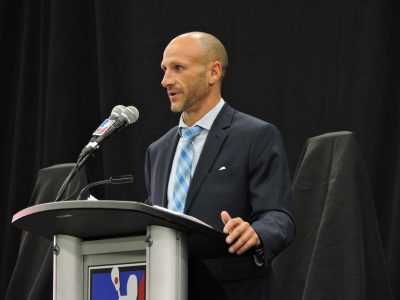

With the National Lacrosse League announcing a few weeks ago that its season would begin on Dec. 29, the league has made several key moves defining its identity. It made some waves when the Toronto Rock traded for Paul Rabil early in the offseason, but the buzz fizzled out before the draft.
After the Rock made a couple of intriguing signings on Monday, though, it became clear there is a potentially new identity forming within the league.
When the NLL brought in former Philadelphia Union (of the MLS) executive Nick Sakiewicz, it was clear that the league would be headed in a new direction. With teams moving to Saskatchewan and Georgia, and the potential for 25 new markets being examined, Sakiewicz has been proactive in improving the league.
The NLL’s web presence has already improved vastly, a talking point for Sakiewicz, and he has also been focused on the league’s marketability. The most watched form of lacrosse has historically been the college level. Since most NLL players are Canadian, the league has lacked a certain star power that American fans yearn for in professional sports.
That is not to say the likes of recent NLL Hall of Fame inductees John Tavares, Josh Sanderson and Tracey Kelusky were not stars. Dhane Smith, Curtis Dickson, Adam Jones and Shawn Evans are currently some of the best players to ever play the game. Yet, those names aren’t drawing in fans like a Paul Rabil might.
When the New England Black Wolves drafted Myles Jones, it was another indication of the league’s new direction. Jones has never stepped inside an indoor lacrosse rink, yet he was selected in the fourth round of last week’s draft and will have a chance to make a competitive roster.
Jones is one of the more recognizable faces in the sport and has been featured in The Players’ Tribune. Of course, that doesn’t mean he’ll have any box lacrosse skill — though he might — but he is already the most popular player on the Black Wolves.
Earlier in the week, the Toronto Rock also brought in two other MLL stars in 2016 MVP Tom Schreiber and 2014 Rookie of the Year Kieran McArdle. Not many American players have found success in both leagues. Casey Powell was an abnormality, and both Drew Westervelt and Brendan Mundorf chose to give up the indoor game.
The overlap between the two league seasons has been well documented, and if MLL players continue to make the jump to the indoor game, that discussion will open up even more. If the Rock were to make the playoffs, and both McArdle and Schreiber were on their roster, they could miss up to five games with their respective MLL teams. Schreiber and McArdle are two of the more popular and marketable players in MLL, and missing those games would hurt those teams on and off the field.
While those players missing games would be an issue, the biggest blow would come if Rabil missed games.
Rabil might be as close as it gets to being a household name in lacrosse. A champion with both Boston and New York, he’s been a key part of what has become a New York Lizards dynasty, and is one of the only draws in the league away from home.
What happens if he were to miss Lizards games? For one, the team would most likely lose some important games with its best player out of the lineup. But for Rabil to choose the NLL over MLL, it would give the indoor game some serious clout as well, and possibly create a resolution.
There is no players’ union in MLL, and the new player movement policy gave the league’s talent some leverage for the first time ever. Rabil signed a two-year deal to remain in New York, but other stars such as Brent Adams and Joe Walters declared their intent to move.
With players gaining that leverage, is the ability to play in both leagues next? Being a full time lacrosse player has never been financially possible, but an even split between the league’s two seasons would make it much more feasible.
The signings of more players than ever crossing over might finally force their hand.